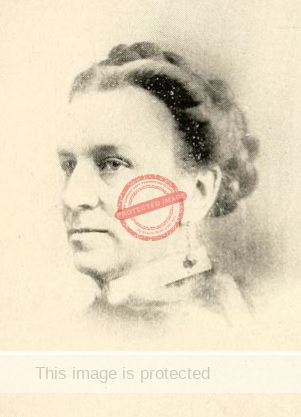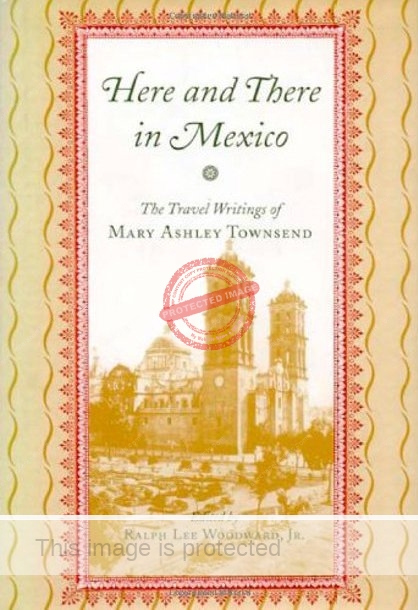In the mid-1890s, New Orleans poet Mary Ashley Townsend, born in 1832, and her husband, Gideon, became, almost certainly, the first American couple to own property in the town of Chapala—and they didn’t even have to pay for it, because it was a gift from their eldest daughter, Cora.
Mary Ashley and Gideon lived in New Orleans, where she had established a reputation as a novelist and poet. She published under several pen names, including Xariffa (or Zariffa) for her serious poetry, and two “humorously masculine names”—Crab Crossbones and Michael O’Quillo—for satirical pieces. As “Poet Laureate of New Orleans,” she was commissioned to compose and recite a special poem for the opening of the New Orleans exposition in 1884.

Mary Ashley Townsend (American Women, 1897)
Mary Ashley was widely traveled and first visited Mexico in 1875. During her extended visits in various parts of Mexico, Mary Ashley published regular columns in papers such as the New Orleans Picayune with astute and informative observations of natural history, architecture, people at work and play, fashion, society, food, etc. She was working on a book based on these columns at the time of her death. The book was only rediscovered and published many decades later, as Here and There in Mexico: The Travel Writings of Mary Ashley Townsend.
Mary Ashley’s daughter Cora Alice Townsend de Rascón (born in 1855) was the widow of wealthy hacienda owner and diplomat José Martín Rascón, the first Mexican minister to Japan, and a confidante of President Díaz. Rascón died unexpectedly in 1893 in San Francisco on his way home to Mexico. After his death, Cora inherited and administered his substantial estate, including several haciendas in San Luis Potosí.
In 1895, Cora bought the Villa Montecarlo from English eccentric Septimus Crowe and gave it to her parents as a Christmas present. A few weeks previously, Cora and her mother had both attended the 11th Congreso Internacional de Americanistas in Mexico City, as had British consul Lionel Carden, who had already started building Villa Tlalocan, his own well-appointed home in Chapala, designed by English architect George Edward King.
Cora’s parents loved Chapala and spent several months each winter there. Gideon Townsend, a financier, liked it for the sake of his health and planted dozens of coffee trees. The Townsend house—at that time the “furthest west of all the cottages”— was a prominent local landmark. According to The Mexican Herald in 1897, “On the highest peak one sees a bright red and white house with a tower which looks as if it came from the old baronial castles of the middle ages.”
Mary Ashley Townsend wrote several poems in Chapala, at least two of which are about the lake. The first, titled “On Lake Chapala” is typical of her lyrical style and offers a halcyon view of her winter home.
“On Lake Chapala”
Oh Nature! soother of the heart that bleeds
Thou, with the boundless beauty of thy skies.
And mountain shapes which improbably rise,
Dost preach thine own among a thousand creeds.
Amid conflicting ways, of words and deeds,
Bewildered man his tangled pathway plies
To clutch at truth where truth his grasp denies,
While thou, the unfailing trinity his soul unheeds!
‘Tis writ oh, Nature! on the veiled winds,
On voiceless planets that our planet nears,
In limpid brooks, in the unfathomed sea—
Writ on the pebble that the lone shore finds,
Writ on the foreheads of the flying years,
Thine was, thine is, thine man shall ever be.
+ + +
The second poem, titled simply “Lake Chapala,” is, in my opinion, far more interesting.
“Lake Chapala”
A sunken city in thy depths tis said,
Fair Lake Chapala, lieth hidden deep,
And water weeds across its casements creep,
Or bar the doors on its unburied dead.
Upon its domes and towers are never shed
The sun’s bright beams, its ancient gateways keep
Grim wardens sleeping an eternal sleep
While through its streets the marching ages tread.
But, in the night time when the moon is low,
The murmuring waves which touch thy tropic shore
The songs of Aztec maidens with them bring
And stronger voices of warriors in their woe
And lovers’ tender accents come once more
Up from the sunken city wandering.
+ + +
This poem relates directly to an idea then circling in the U.S. that an early town or city at Lake Chapala had been submerged and now lay under water. Distinguished American anthropologist Frederick Starr (1858-1933) spent the winter of 1895-1896 at Lake Chapala investigating the rumors of this submerged city, rumors based mainly on the large number of pottery fragments recovered from the lake bed whenever the water level fell. After collecting and studying 261 individual specimens of pottery, Starr concluded that they were likely to be “offerings made to the lake itself or some spirit resident there-in,” and not utilitarian household items. Starr also recognized that changes in lake level might explain why the pieces were now found at some distance from the current shoreline.
 In “Lake Chapala,” Mary Ashley Townsend, looking across the waters of the lake from her stately residence, Villa Montecarlo, indulged her imagination and poetic talents.
In “Lake Chapala,” Mary Ashley Townsend, looking across the waters of the lake from her stately residence, Villa Montecarlo, indulged her imagination and poetic talents.
Unfortunately, tragedy would soon befall her family. Her eldest daughter, Cora, married Bannister Smith Monro, a New Yorker living in Europe, in 1896, and moved to Paris. The Monros’ daughter (Cora Monro) was born the following year, and their son a year later. Tragically, on 28 March 1898, Cora died within days of giving birth to their son, who died only a few weeks later. As if this wasn’t enough ill-luck, Bannister died on 15 August 1899. Young Cora Monro, orphaned before she was three years old, inherited the massive land holdings in Mexico, and was taken in by her maternal aunt, Mrs George Lee, in Galveston, Texas. Mary Ashley’s husband, Gideon, also died in 1899, meaning that Mary Ashley had lost her eldest child, as well as a grandson, a son-in-law and her own husband within two years. The run of bad luck did not end there. Mary Ashley was severely injured in a train crash in Texas, and suffered months of ill health prior to her own death on 7 June 1901.
The Montecarlo property was eventually acquired—the conflicting versions of how this occurred are impossible to reconcile and leave several unanswered questions—by Aurelio González Hermosillo (1862–1927), a wealthy lawyer and financier who owned the Hacienda Santa Cruz del Valle near Guadalajara.
Note that American historian John Mason Hart’s account of Cora’s life in Empire and Revolution: The Americans in Mexico Since the Civil War, is error-strewn. His claim, for example, that Rascón died in 1896 and that Cora Townsend then continued to run the hacienda, very successfully, for another decade, until her own death in 1906, is clearly wrong since Rascón died in 1893 and Cora in 1898.
Chapter 28 of If Walls Could Talk: Chapala’s Historic Buildings and Their Former Occupants (translated into Spanish as Si las paredes hablaran) includes more discussion of the Townsends’ ownership of Villa Montecarlo.
Acknowledgment
- My sincere thanks to Michael Olivas for investigating the Stanton-Townsend Papers in the Special Collections Division of the Howard-Tilton Library at Tulane University, New Orleans.
Sources
- James Mason Hart. 2002. Empire and Revolution: The Americans in Mexico Since the Civil War. University of California Press, page 398.
- Mary Ashley Townsend. Undated, unpublished manuscripts, Box 3, Folder 17, Stanton-Townsend Papers, Special Collections Division, Howard-Tilton Library, Tulane University, New Orleans.
- Mary Ashley Townsend. 2001. Here and There in Mexico: The Travel Writings of Mary Ashley Townsend. (edited by Ralph Lee Woodward, Jr.) University of Alabama Press.
- The Salt Lake Herald: 16 November 1895.
- Starr, Frederick. 1897. “The Little Pottery Objects of Lake Chapala, Mexico.” Department of Anthropology Bulletin II. University of Chicago Press, Chicago.
Comments, corrections and additional material are welcome, whether via comments or email.
Tony Burton’s books include “Lake Chapala: A Postcard History” (2022), “Foreign Footprints in Ajijic” (2022), “If Walls Could Talk: Chapala’s historic buildings and their former occupants” (2020), (available in translation as “Si Las Paredes Hablaran”), “Mexican Kaleidoscope” (2016), and “Lake Chapala Through the Ages” (2008).
Thank you once again for this work. It always raises so many questions for me concerning the person and era: how they traveled, dined etc. This type account also makes me wish I had a few more lifetimes to read and research further people like this lady and her era.